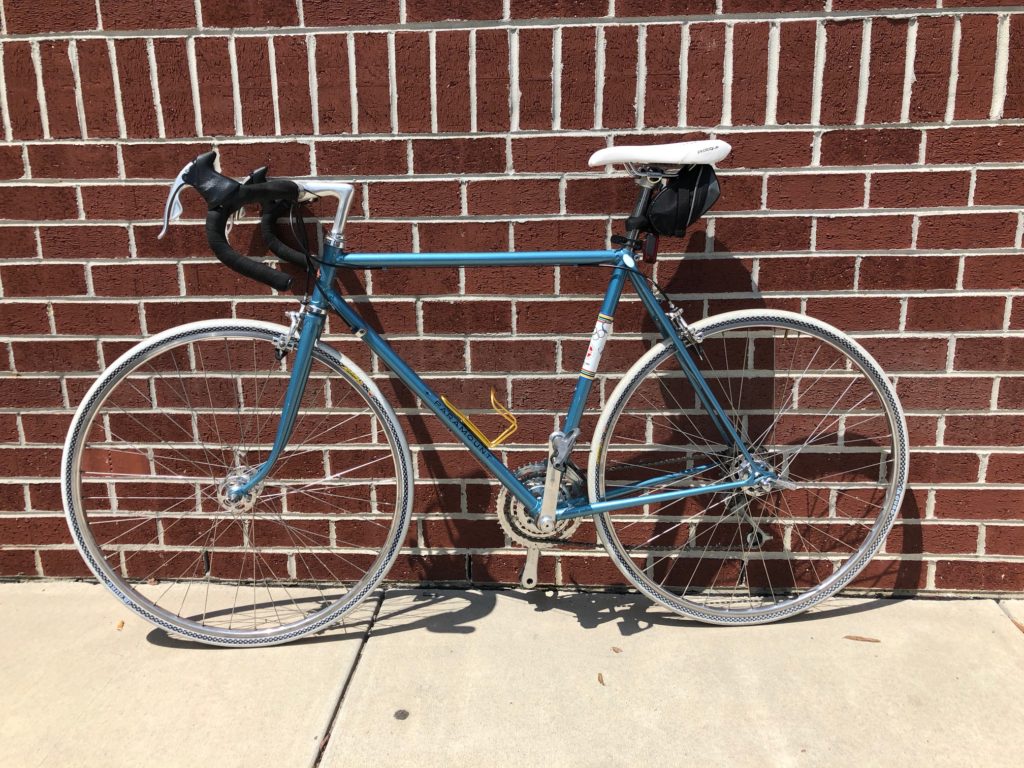 Above is one of the first SLR cameras I owned as a kid, A Mamiya/Sekor 528TL. I was 12. It was an amateur’s camera, a fixed lens SLR with telephoto and wide angle attachments. I didn’t keep it long. What I wanted was a Nikon F. You could change lenses on the Nikon F. To a 12 year old, that seemed incredibly cool, the ability to change lenses. The Mamiya was decidedly not cool, so I convinced my parents that I needed a better camera and the Mamiya went wherever unused cameras went back in 1970.
Above is one of the first SLR cameras I owned as a kid, A Mamiya/Sekor 528TL. I was 12. It was an amateur’s camera, a fixed lens SLR with telephoto and wide angle attachments. I didn’t keep it long. What I wanted was a Nikon F. You could change lenses on the Nikon F. To a 12 year old, that seemed incredibly cool, the ability to change lenses. The Mamiya was decidedly not cool, so I convinced my parents that I needed a better camera and the Mamiya went wherever unused cameras went back in 1970.
A few years ago I ran across one on Ebay and bought it on a whim – it was $10. I figured, why not, I’d put it up on the shelf as a piece of nostalgia, maybe even use it occasionally when feeling in a retro mood. Once I got it in the mail I realized my initial 12 y/o’s assessment of the camera had been pretty much correct. It was a piece of junk, made in Korea, obviously thrown together without much thought to precision or longevity, a 1970’s era throw-away.
Which is unusual. Film cameras back in the day were typically built robustly, made to last, not in thrall to a consumerist ethic that required replacement with “better” technology every 18 months or so. Not that manufacturers wouldn’t have liked us to be buying a new camera every 18 months; it was just that the mechanical technology was static in a way that didn’t lend itself to constant upgrading, so cameras were typically built solidly, with longevity and robustness as a selling point. You’d buy a camera – a Nikon F or a Leica M – with the understanding that you’d keep it for a lifetime. There might be newer models to come along, something a little sexier, but basically the same technology presented in a new package.
Where it all began to change was with the introduction of electronics in cameras – meters, and then auto exposure and auto focus – and the pace of technology dictated that cameras became consumer goods, something with a limited technological shelf life that required upgrading at fixed intervals. As such, the notion of robustness, building something with longevity in mind, became an anachronism. Of course there were exceptions – the M5 and M6 come to mind, as does the Nikon F2 and Canon F1.
*************
This all came back to me the other day as I was out riding my new (to me) Schwinn Paramount road bike. Growing up, I admired fine road racing bikes the way I admired fine cameras. And back in 1970, at least here in the States, there was nothing more desirable and exclusive than a Paramount. I remember seeing one hanging in the window of the bike shop, a beautiful jewel of a bike, ridiculously expensive and out of reach for most people, certainly for a kid like me. One day, I told myself, I’d have a Schwinn Paramount.
The Paramount has an interesting history. It was first produced by Schwinn, a large American bicycle maker, in 1938, and remained essentially the same bike up through the mid-80’s, when bike technology started a progressive trajectory much like cameras. Schwinn hired an old world master frame maker – Emil Wastyn – to build frames for Schwinn’s professional six-day racing team. Emil ran a bicycle frame shop not far from the Chicago Schwinn factory. Soon, a select number of Paramount-labeled bikes began to appear for sale to the general public.
During the next twenty years, Wastyn hand-built all Schwinn’s Paramounts at his shop. The earliest Paramounts followed his signature styling (balled-end seat stays, for example) and keyhole-styled lugs. Over the years, Paramounts gradually evolved their own specific style – particularly the famous slant trimmed seat stays which remained in effect for 50 years. Schwinn also produced a variety of machined components to complement the frame – beautifully crafted wide-flange hubs, stems, handlebars and even pedals, each marked with the Schwinn name in script. By the 60’s, Schwinn had brought hand-built production in shop and offered Paramounts with top of the line Italian Campagnolo components, with corresponding prices to match.
Think of the Schwinn Paramount as the Leica of American made racing bikes, the best, most refined version of a steel framed road racing cycle, a no-expense spared hand built machine with functionality as its premier design feature, nothing extraneous or thrown in for fashion. Like Leicas, they’ve become collectors items for guys my age, nostalgic for the things they wanted but couldn’t afford in their youth. Technologically, they’re simple, 22 lb fully mechanical lugged steel framed and shiny chromed artworks. Most collectors hang them on the wall and never ride them, which is a shame, because, as I’ve discovered, they’re still sublime to ride even 50 years old.
*************
My 1969 Schwinn Paramount P-13
Above is my Paramount, which I’ve owned for all of two weeks. I found it on a whim on Craigslist in Richmond, VA, a 200 mile ride from my home in North Carolina. It was being sold by the original owner, and he had receipts back to his purchase of the bike in 1969. It wasn’t period correct in that he had upgraded the drive train to a 90’s era Campagnolo 8 speed with modern style shifters, but it still had the same beautiful box section wheels with high-flange Campy hubs, and the drive train upgrades were top of the line Campagnolo circa 1992. And it looked in good condition from the pics he posted. And it was cheap. I called him, paypalled him the asking price sight unseen, then rode to Richmond to pick it up. The bike was pristine, obviously cared for, almost new, and mechanically, everything worked perfectly. I drove home marveling at my good fortune.
My intent had been to strip the frame, sell the vintage Campy components and replace them with a modern groupset with modern wheels. As such, I’d have the best of both worlds – a beautiful hand built steel lugged frame mated to modern lightweight components. One ride on the bike changed my mind forever. Its 10 mile shakedown ride turned into a 6 hour, 100 mile ride – without the usual earbuds and ZZ Top blasting away over the creaking of the carbon fiber frame – cruising eastern North Carolina farm roads. Used to riding 17 lb carbon fiber bikes, I assumed my Paramount ride would feel heavy and slow and harsh, probably accompanied by the metallic twang of misaligned gears and loose nuts and bolts. Instead, the Paramount rode perfectly quiet, the 50 year old hubs rolling along with a smooth effortlessness I’d never experienced before, not a rattle anywhere on the bike, everything solid and purposeful. And it felt light. Sprinting out of the saddle or climbing hills was a revelation of what a bike should feel like. In short, the Paramount offered something close to perfection, a sublime experience of a machine perfectly matched to its function.
It made me think of my Leica M4, produced during the same year as my Paramount. From a technical perspective, hopelessly outdated, laughable almost when compared to the M10 or the D800, good only for nostalgia. In reality though, it’s just the opposite, the Paramount and the M4 two examples of machines of profound elegance, perfectly made for their intended purpose, made with an artisanal pride and built to last seemingly forever, unlike today’s “imaging devices” and 15 lb carbon fiber bikes.
*************
Just Shoot Me If I Ever Become This Guy
I hate nostalgia for nostalgia’s sake. Sometimes, old stuff is just shitty old stuff, as my Mamiya 528TL proves. I don’t ever want to become that guy with the M4 and the beret who fancies himself Josef Koudelka with all the period correct lenses etc, or the old guy with the 60’s era wool jersey and the leather helmet out for his Sunday “L’Eroica” retro ride. That attitude doesn’t befit the inherent worth of the M4 or the Paramount, two beautiful hand crafted machines that work perfectly for their intended use, and as such, are not “vintage” and will never be obsolete.
I’ve been riding the hell out of the Paramount since I’ve gotten it. It’s shined up perfectly, cleaned top to bottom, not a scratch on it, but I’m intent on riding it hard, using it for its intended purpose, much like I still use my Leica film cameras. They weren’t made to put on a shelf or hang on a wall. They were made to be used, and the pleasure of their use will prevent them from ever becoming obsolete, which is not something you can say for a camera or a bicycle you can buy new today.



